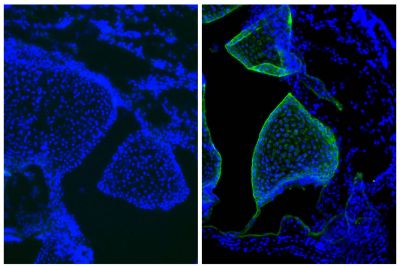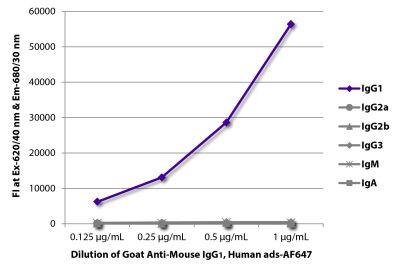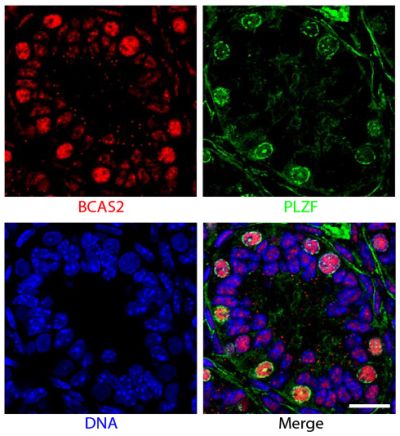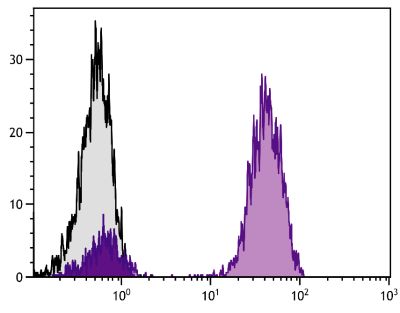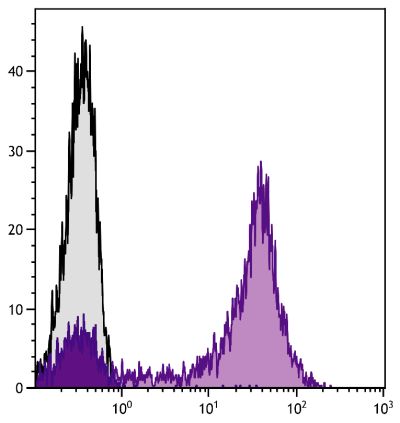Mouse Anti-Human CD3-UNLB (UCHT1)
Cat. No.:
9515-01
Purified Anti-Human CD3 antibody for use in flow cytometry, immunohistochemistry / immunocytochemistry, western blot, immunoprecipitation, activation, and blocking assays.
$97.00
| Clone | UCHT1 |
|---|---|
| Isotype | Mouse (BALB/c) IgG1κ |
| Isotype Control | Mouse IgG1-UNLB (15H6) |
| Specificity | Human CD3 |
| Alternative Names | CD3ε, T3E, TCRE, Leu-4, T3 |
| Description | CD3, a member of the immunoglobulin superfamily of cell surface receptors, is comprised of five invariable chains ranging from 16-28 kDa and is closely associated with the T cell antigen receptor (TCR). CD3 is expressed on 70-80% of normal peripheral blood lymphocytes and on 10-20% of thymocytes. It plays a major role in signaling during antigen recognition, leading to T cell activation. The monoclonal antibody UCHT1 reacts with the 20 kDa ε chain of the CD3/TCR complex. |
| Immunogen | Human peripheral blood lymphocytes from a patient with Sézary's syndrome and infant thymocytes |
| Conjugate | UNLB (Unconjugated) |
| Buffer Formulation | Borate buffered saline, pH 8.2 |
| Clonality | Monoclonal |
| Concentration | 0.1 mg/mL |
| Volume | 1.0 mL |
| Recommended Storage | 2-8°C |
| Applications |
Flow Cytometry – Quality tested 1,6-11 Immunohistochemistry-Frozen Sections – Reported in literature 4,5 Immunohistochemistry-Paraffin Sections – Reported in literature 5 Immunocytochemistry – Reported in literature 1 Immunoprecipitation – Reported in literature 2 Western Blot – Reported in literature 3 Activation – Reported in literature 1,2 Blocking – Reported in literature 2 |
| RRID Number | AB_2796826 |
| Gene ID |
916 (Human) |
| Gene ID Symbol |
CD3E (Human) |
| Gene ID Aliases | T3E; TCRE; IMD18 |
| UniProt ID |
P07766 (Human) |
| UniProt Name |
CD3E_HUMAN (Human) |
Documentation
Certificate of Analysis Lookup
Enter the Catalog Number and Lot Number for the Certificate of Analysis you wish to view
- 1. Beverley PC, Callard RE. Distinctive functional characteristics of human "T" lymphocytes defined by E rosetting or a monoclonal anti-T cell antibody. Eur J Immunol. 1981;11:329-34. (Immunogen, ICC, Activ, FC)
- 2. Burns GF, Boyd AW, Beverley PC. Two monoclonal anti-human T lymphocyte antibodies have similar biologic effects and recognize the same cell surface antigen. J Immunol. 1982;129:1451-7. (IP, Activ, Block)
- 3. van Dongen JJ, Krissansen GW, Wolvers-Tettero IL, Comans-Bitter WM, Adriaansen HJ, Hooijkaas H, et al. Cytoplasmic expression of the CD3 antigen as a diagnostic marker for immature T-cell malignancies. Blood. 1988;71:603-12. (WB)
- 4. Patey-Mariaud de Serre N, Cellier C, Jabri B, Delabesse E, Verkarre V, Roche B, et al. Distinction between coeliac disease and refractory sprue: a simple immunohistochemical method. Histopathology. 2000;37:70-7. (IHC-FS)
- 5. Pollard K, Lunny D, Holgate CS, Jackson P, Bird CC. Fixation, processing, and immunochemical reagent effects on preservation of T-lymphocyte surface membrane antigens in paraffin-embedded tissue. J Histochem Cytochem. 1987;35:1329-38. (IHC-FS, IHC-PS)
- 6. Nistala K, Moncrieffe H, Newton KR, Varsani H, Hunter P, Wedderburn LR. Interleukin-17-producing T cells are enriched in the joints of children with arthritis, but have a reciprocal relationship to regulatory T cell numbers. Arthritis Rheum. 2008;58:875-87. (FC)
- 7. Hunter PJ, Nistala K, Jina N, Eddaoudi A, Thomson W, Hubank M, et al. Biologic predictors of extension of oligoarticular juvenile idiopathic arthritis as determined from synovial fluid cellular composition and gene expression. Arthritis Rheum. 2010;62:896-907. (FC)
- 8. Farag MM, Weigand K, Encke J, Momburg F. Activation of natural killer cells by hepatitis C virus particles in vitro. Clin Exp Immunol. 2011;165:352-62. (FC)
- 9. Rossi LE, Avila DE, Spallanzani RG, Ziblat A, Fuertes MB, Lapyckyj L, et al. Histone deacetylase inhibitors impair NK cell viability and effector functions through inhibition of activation and receptor expression. J Leukoc Biol. 2012;91:321-31. (FC)
- 10. Domaica CI, Fuertes MB, Uriarte I, Girart MV, Sardañons J, Comas DI, et al. Human natural killer cell maturation defect supports in vivo CD56bright to CD56dim lineage development. PLoS One. 2012;7(12):e51677. (FC)
- 11. Henn AD, Wu S, Qiu X, Ruda M, Stover M, Yang H, et al. High-resolution temporal response patterns to influenza vaccine reveal a distinct human plasma cell gene signature. Sci Rep. 2013;3:2327. (FC)
See More


